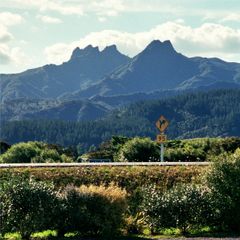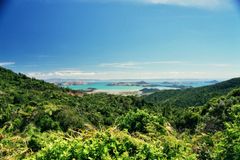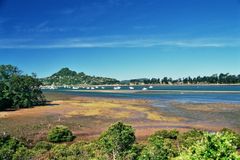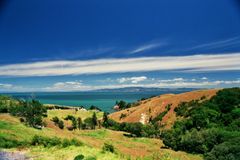The Coromandel East Coast
Coromandel

Coromandel is one of New Zealand's earlier hippy destinations and served as a retreat from suburbia for young people from the 1960's on. Swathes of young people set up artist colonies, homesteading, organic farms, beekeeping and pottery. Most of the communes failed as idealism drifted out of their sails and they left or settled into satellite dishes, internet and tourism ventures. Coromandel still carries an atmosphere of the alternative however, and this gives it a good feeling. The YHA has camping attached to the hostel and the township itself is substantial with all the facilities you require. Coromandel, like Thames, has a history of gold-mining. I have a question mark next to the local campground however. On the one occasion I camped there someone decided to have a meal and regale the campers with their music at 3.00 am. The camp owner appeared absent and the experience was such I wouldn't go there again. A kilometre or two out of Coromandel (if you turn left from the main street) is a very beautiful campground close by a beach called Long Bay. This is a great spot, very pretty, with camping on the foreshore. The Information Centre should give you all the instructions you need.

At this point I recommend turning off the west coast and heading over the hill to the east. You can of course continue on a sealed road up to Colville (small store/camping) and beyond to Fletcher's Bay with some excellent and beautiful scenery and campsites available on unsealed roads right up to the tip of the peninsula. There is a loop road that is unsealed, narrow and winding but very scenic. It leads to Kennedy Bay and Waikawau Bay on the east coast and there are a range of DOC camps and possible free camping sites available. But be aware there is no through road and you have to return eventually to Coromandel town. Beautiful places but, given the rough roads and isolation, I would only recommend this route to the more stalwart cycle tourists. If you go beyond Coromandel into the area around Mount Moehau, you may also be interested in the following legend...
Coromandel's Yeti
Beyond Coromandel are a number of rugged ranges and hills. One in particular is Mount Moehau. Local legend, going back to the Māori, has it that a monster lives in this remote area. It has been described as being about two metres tall and covered with silver-white hair. It has large, pink, vacant eyes and its body is ape-like, with long arms and short thin legs. In the evenings, its growl can be heard over long distances. Be warned, if you ask locals about this creature, most will respond with scepticism, yet there was apparently a sighting in 1969...
Coromandel to Whitianga

There are several routes over Coromandel from west to east. The best I suggest is Highway 25. It is certainly the most direct, it is sealed and probably the least hilly. The drawback is that it is also the busiest. The other routes are steep, unsealed in large sections and narrow and winding and often leave you vulnerable to traffic on tight bends. Highway 25 route starts with a long steep climb... beautiful views, but 5 km to the scenic lookout at the top. No stores. Three ks of downhill are followed by undulating often hilly road and you are on your way through the Coromandel Ranges. As you approach the eastern side you notice a shift in geography. The beaches of the west coast tend toward leafy bays that are sometimes shingle and sometimes sand. The east coast beaches are broader and sandier and many are popular with surfers. There is also the sense that tourism and an accompanying affluence plays a greater role on the east coast.
After the seascapes of the west coast you are travelling through dense native bush with ferns and nikau that gradually give way to pine forests and small settlements. There are several turn-offs to beaches and campgrounds, most of which are isolated, but beautiful and most of the campgrounds have a basic store for supplies.
There is a campground at Kūaotunu (25 ks from Coromandel) a beautiful place looking out toward the Mercury Islands. For more beautiful and isolated beaches, you can head up Black Jack Road which is the turn-off that leads to Otama and Opito Bay. These are two remote and beautiful sandy beaches.

The road climbs steadily out of Kūaotunu and then dips and winds through more bush and farmland. Eventually you arrive at Mercury Bay and Whitianga. A fair sized well-established seaside town fringed with retirement homes and offering most tourist attractions like kayaking etc. There are several hostels and campgrounds. The best route I suggest is to stock up and take a ferry over to the lovely beaches and camping grounds around Cooks Beach, Hahei and Hot Water Beach. You might like to take a trip out to Cathedral Cove or Hot Water Beach, famous for its hot springs. At low tide you dig a hole in the sand and it fills with warm water for you to lie in. This is a relatively quiet loop road and you can rejoin Highway 25 at Whenuakite (campground, hostel).
Whitianga to Tairua

If you skip the loop road, continue on Highway 25; a flat start to a winding, hilly day. There is more undulating farmland and another campground 10 ks out at Kaimarama. Sixteen ks further out is the Coroglen Tavern, a well known haunt for local rock bands. A slow winding hill takes you into Tairua with impressive views of the islands and Ocean Bay. Coming down you pass the Twin Kauri reserve on your left, a food opportunity to see examples of giant kauri trees. Tairua, which translates as 'two hills', has two distinct beaches, one open and broad and the other bounded by an estuary. There are several hostels and a campground. It is a small town but has most facilities. It also has a ferry that can take you across to Pauanui, yet another seaside town, somewhat new and suburban, but beautifully situated. There is also a loop here which allows you to come back onto Highway 25 further on.
Alternately, there is a forestry road from Pauanui directly to Opoutere. A friend of mine tackled this some years ago and recommends it. However the road may well be private and you may wish to check this out before you head in that direction. It appears a good short cut and there is unlikely to be any traffic.
Tairua to Opoutere

The road meanders along the estuary on your left and on the right is the rugged hinterland of the Coromandel ranges. Plenty of old mine shafts and the remains of old stamper batteries. Gold is still up there they reckon. Take a sharp left (signposted) 11 ks out of Tairua and, after 8 ks or so, there is is the turn off to Opoutere. Follow the level road alongside the estuary and it eventually leads out to the Wharekawa Harbour and Opoutere.
I am a great fan of Opoutere and while it is off the highway and lacks a large store, it is nonetheless a very pretty spot with a YHA hostel that takes tents. Opoutere also has a regular campground closer to the beach. The beach is wonderful and the surrounding hills have tracks to wander up and look down and over the bay. The YHA has a very basic store so it is best to take in supplies. You can easily spend two or three days here. After Opoutere, cycle back out onto the main highway and a further ten or so fairly easy kilometres will take you into Whangamatā, an established town with all facilities and a pretty foreshore. Another small aside...
The oldest touring cyclist I ever met was here at Opoutere; a wonderful German man called, perhaps inappropriately, Adolph. Adolph was 75 years old and touring a foreign country with little English but a lot of good heart and attitude. He accompanied me on a walk to the top of one of the lookouts overlooking the estuary. This was a stiffish climb but he reached the top without pause or panting. A few days later I saw him cycling up one of Coromandel's steeper climbs with full panniers. He was going well and that was the last I saw of him.
However, Adolph was not the most remarkable senior cyclist I have met. That honour goes to an anonymous elderly Englishman I met on the road in France. This man had just finished the Camino across Northern Spain and was cycling back to the UK. I surveyed his bike and innocently inquired why he rode on a bike that had an old fashioned step-through woman's frame. He smiled and told me he had an artificial hip and couldn't lift his leg over a regular, higher, crossbar.
Whangamatā to Waihi

The road winds slowly inland and takes you eventually into Waihi, another established town with all facilities. Waihi marks the end of the Coromandel tour and from here you have choices of where to head next. By far the most scenic and most recommended beauty spot is a tour of East Cape. Or you might want to head to Wellington in the south. Some tourists are eager to head to Rotorua and view mud pools and geysers (a bit overrated in my opinion). Either way you are going to encounter a bit of traffic and logging trucks as you skirt or enter the region known as the Volcanic Plateau to the south or the more heavily populated area around Tauranga to the east. Some catch a bus at this point either to Whakatāne or to Rotorua. This will cut out the worst of the traffic. Whichever route you choose, the landscape is always wonderful.